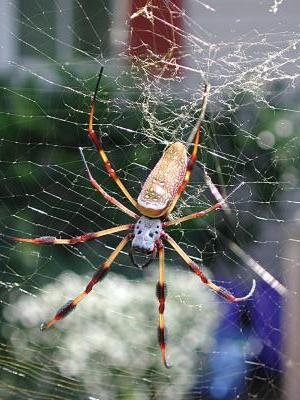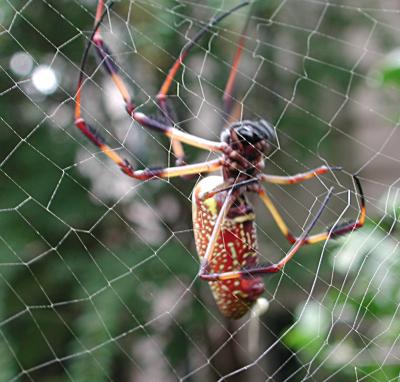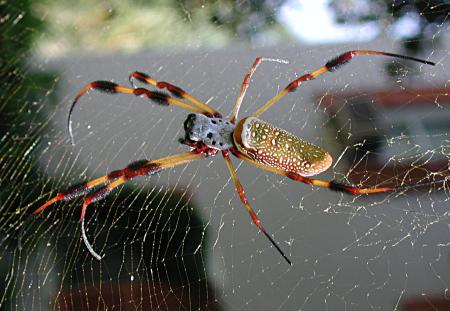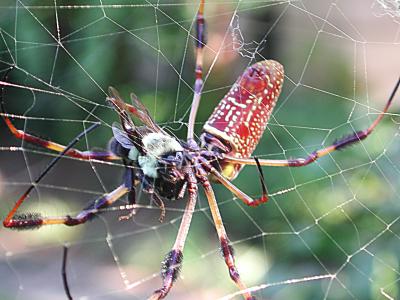| |||||||||||||||||||||
| A few weeks in the life of Natasha: Her story | |||||||||||||||||||||
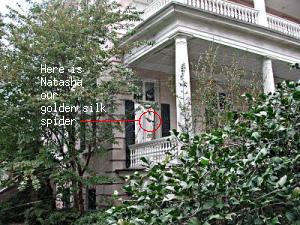
I have had fun watching Natasha (a golden silk or banana spider, Nephila clavipes) and experiencing the excitement of watching her on the Discovery Channel (Super Hero Science, May 4, 2003). Here is the photo essay from beginning to end - a way of sharing with my grandkids some of the excitement of watching nature at its best. It all started when I returned from my trip to Pushchino. Home was waiting as usual, but this time, something new - a banana spider (calico spider) spider or golden silk spider or technically Nephila clavipes (thanks to Google: my new 21st century learning paradigm). Not only was she beautiful, but the golden silk was incredibly strong. She is a member of a class of orb weaving spiders and is highly skilled in building, maintaining and rennovating her web. So what to do? Take some photos of course - and maybe some of them would turn out to be interesting. At first, if you look into our garden with ordinary eyes, you see almost nothing - a small speck againt the background of the home. However, if you look with your curious eyes, you see a complete web (from the opposite side) and in the upper part, there sits Natasha, Nephila clavipes , banana spider or golden silk spider. Here is her web - showing the relative proportions - the total length of the golden silk web spans about 3-4 meters - and the diameter of the primary structure is about 1 meter. Within this region, she catches small and large insects (mosquitoes, bumble bees), and has a tasty treat. Her silk is the strongest fiber known. While scientists have been able to sequence the golden silk spider silk gene and actually synthesize the protein, the trick for extruding super-strong silk eludes us. To give you an idea of the dynamics of a golden silk or banana spider and the ballet that is continuously performed, I've added several video segments revealing weaving, hunting and night time activities.
Below is our story: There was much learning for me. First, I needed to identify her - known locally as a banana spider, what was her "official" name? A Google image search ( I've forgotten the key words) suggested that she was Nephila clavipes. Next I had to learn how to do close focus work with the Coolpix 990 - then I had to learn about depth of field and playing games with exposure. All these things come naturaly to some folks, but for me the long feedback when using a film camera made learning difficult. With a digital camera, though, learning was immediate and quickly I grasped the tradeoff between lens opening and shutter speed. Then the most difficult lesson - patience. This was followed by a video learning experience - how to capture the digital video (Sony camera) - then filter, edge enhance and compress. Chris Badea lead me through this jungle - recommending some very nice software tools.
Some more important data: her web is approximately 2 meters above ground level, the supports (between two bushes) are between 2 and 3 meters in length and the diameter of her web is approximately 1 meter. Hunting seems most likely at night, when insects cannot see the net. It appears that she uses her legs to hold a constant tension on the web radials in order to sense transient motion. She completely discounts slow or low frequency motion of the web (wind or me plucking a support thread). When she launches an attack, she grabs the insect and if on the other side of the web, she tears the web in order to retrieve the insect (we viewed this with a cockroach we fed her. She repairs her web in the morning - typically only a sector approximately half - sometimes more, sometimes less. The weaving is accomplished by extruding the silk and using the distal end of her thorax to glue it to the radial segments of the web. Typically she weaves a course set of circumferential elements, separated by 1 - 2 cm and then returns to fill in between these elements - with a circumferential spacing of about 2 mm.
 This work is licensed under a Creative Commons License. |
|||||||||||||||||||||
